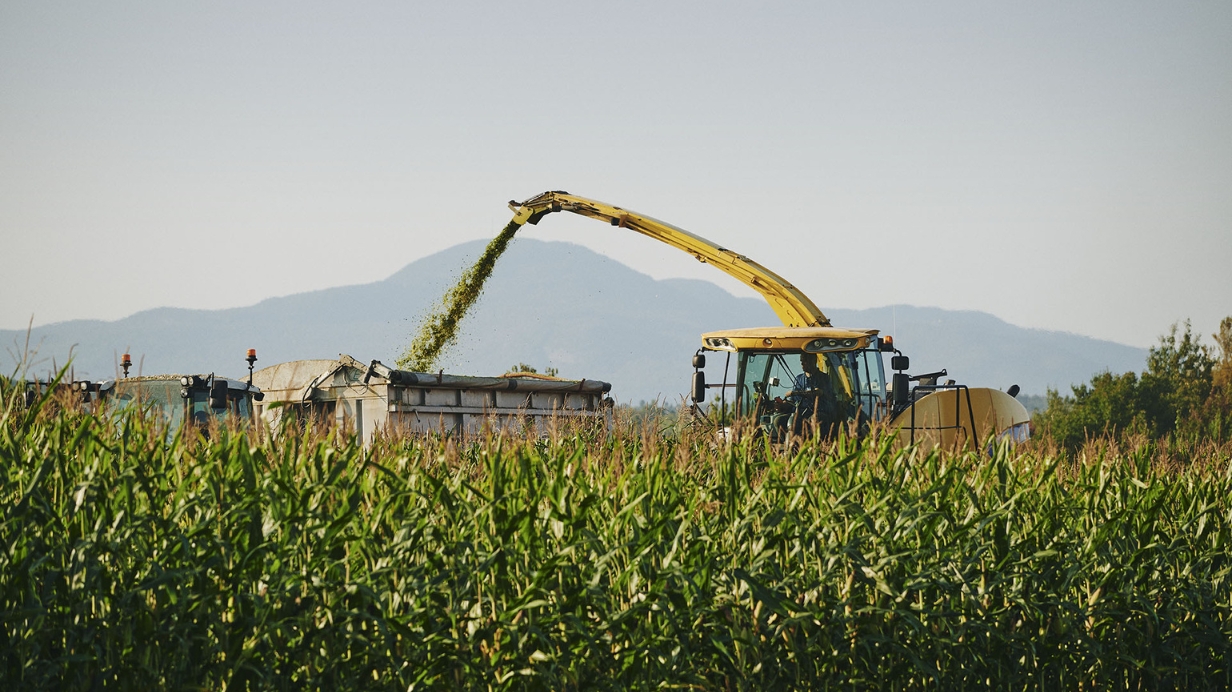5 questions for a better corn silage harvest
Corn silage is a staple feed for most dairy herds, so it’s important to make sure it’s the best quality possible. Here are five questions to ask yourself when getting ready for your corn silage harvest, with technological tools and sustainable agriculture expert Élise Gagnon and sales support advisor Raoul Ruel.
Question 1: When is the best time to harvest corn silage?
Élise: That question comes up a lot! The top factor in timing your harvest isn’t the milk line or what your neighbour is doing. It’s maturity. And one way to determine maturity is by measuring dry matter.
Agri-advisors from the Sollio Agriculture cooperative network can help you take representative samples from your fields and calculate your percentage of dry matter.
Ideally, you should harvest when the dry matter content is between 30% and 35% on average, but this varies depending on your storage structure. Here’s the general breakdown:
32% to 35% dry matter for conventional tower silos up to 60 feet high
2% more for every 10 feet of additional height (for example, 40% for 100-foot tower silos)
30% to 35% for bunker silos and stacks
32% to 35% for silage bags
If your silage isn’t mature enough and is still too wet, it may lead to nutrient loss. But if your silage is too dry, it’ll have an impact on starch and fibre digestibility—and in turn, the energy content.
Question 2: What’s the best chop length?
Élise: If you have kernel processors—and you should, because studies show they have a positive impact on starch digestibility—aim for:
3/4 inch for higher-moisture silage (30% to 32% dry matter)
3/8 inch or shorter for lower-moisture silage
And remember, it’s important to check that your kernel processors are calibrated properly. Ideally, the gap between the rollers should be 1 to 3 mm.
If you don’t have kernel processors, the grain is harder to break down, so you’ll want a shorter chop length of 1/4 to 3/8 inch.
Chop length should also be adjusted based on the proportion of the feed ration it takes up. If corn silage is the main forage in your ration, it should be cut longer.
Question 3: What’s the best cutting height?
Élise: There’s research showing that you get increased digestibility and starch content from cutting at 16 inches. Other sources recommend 6 to 9 inches.
The key is that the plant has more fibre at the bottom, which helps it stay upright. That means a lower cutting height will give you more volume, but also more risk of contamination and less nutritional value. In other words, you’ll have better yields per hectare at the cost of lower silage quality. The opposite is true if you cut higher.
Question 4: What if my corn silage freezes?
Élise: Corn will generally freeze if exposed to temperatures of -2 °C for a few minutes or 0 to -2 °C for four hours or more.
If this happens, you’ll need to keep a close eye on dry matter for the next few days, as it can change rapidly depending on the temperature.
Unfortunately, even if you reach ideal dry matter, corn that’s been frozen is lower in starch. And lower starch means less energy in the ration. So, you’ll have to fill it out with other sources of energy, which will mean additional costs.
Question 5: Should I use an inoculant?
Raoul: As fermentation boosters, inoculants deliver several benefits—even in ideal harvesting conditions.
Better dry matter recovery: Inoculants can rapidly lower pH and improve aerobic stability, for better recovery.
Enhanced fermentation: Inoculants add bacteria, which reduces mould.
Reduced protein loss: Lactococcus lactis inhibits the growth of clostridia, thereby reducing ammoniacal nitrogen and butyric acid.
Less mycotoxins: Rapidly lowering pH also inhibits the growth of mycotoxin-producing mould.
In short, using inoculants with your corn silage translates into better dairy farm performance. Try our featured inoculants, Enersile Gold and SiloSolve FC, which each contain a different strain of Lactococcus lactis for optimal results.

